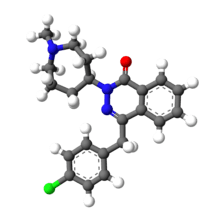Azelastine
 | |
 | |
| Clinical data | |
|---|---|
| Trade names | Astelin, Optivar, among others.[1] |
| AHFS/Drugs.com | Monograph |
| MedlinePlus | a603009 |
| Pregnancy category |
|
| Routes of administration | intranasal, ocular |
| ATC code | R01AC03 (WHO) R06AX19 (WHO), S01GX07 (WHO) |
| Legal status | |
| Legal status |
|
| Pharmacokinetic data | |
| Bioavailability | 40% (intranasal) |
| Biological half-life | 22 hours |
| Identifiers | |
| |
| CAS Number |
58581-89-8 |
| PubChem (CID) | 2267 |
| IUPHAR/BPS | 7121 |
| DrugBank |
DB00972 |
| ChemSpider |
2180 |
| UNII |
ZQI909440X |
| KEGG |
D07483 |
| ChEBI |
CHEBI:2950 |
| ChEMBL |
CHEMBL639 |
| Chemical and physical data | |
| Formula | C22H24ClN3O |
| Molar mass | 381.898 g/mol |
| 3D model (Jmol) | Interactive image |
| |
| |
| (verify) | |
Azelastine is a potent, second-generation, selective, histamine antagonist (histamine-H1-receptor antagonist) used as a first line therapy of mild intermittent, moderate/severe intermittent and mild persistent rhinitis (new classification system for rhinitis).
Azelastine has been formulated both as a nasal spray and as eye drops and are available worldwide under many brand names.[1]
Medical uses
Azelastine nasal spray is indicated for the local treatment of the symptoms of seasonal allergic rhinitis and perennial allergic rhinitis, such as rhinorrhea, sneezing and nasal pruritus in adults and children 5 years of age and older.[2][3][4] In some countries, it is also indicated for the treatment of vasomotor rhinitis in adults and children ≥ 12 years old.[4] Azelastine eyes drops are indicated for the local treatment of seasonal and perennial allergic conjunctivitis.[5][6]
Side effects
Azelastine is safe and well tolerated in both adults and children with allergic rhinitis.[7][8][9] Bitter taste, headache, nasal burning and somnolence are the most frequently reported adverse events. US prescribing recommendations warn against the concurrent use of alcohol and/or other central nervous system depressants, but to date there have been no studies to assess the effects of azelastine nasal spray on the CNS in humans. More recent studies[10][11] have shown similar degrees of somnolence (approx. 2%) compared with placebo treatment. The problem of bitter taste may be reduced by correct application of the nasal spray (i.e. slightly tipping the head forward and not inhaling the medication too deeply), or alternatively using the azelastine/sucralose formulation.
Pharmacokinetics and metabolism
The systemic bioavailability of azelastine is approximately 40% when administered intranasally. Maximum plasma concentrations (Cmax) are observed within 2–3 hours. The elimination half life, steady-state volume of distribution and plasma clearance are 22 h, 14.5 l/kg and 0.5 l/h/kg respectively (based on intravenous and oral administration data). Azelastine is oxidatively metabolized by the cytochrome P450 family into its active metabolite, desmethylazelastine, and two inactive carboxylic acid metabolites. Approximately 75% of an oral dose is excreted in feces. Pharmacokinetics of orally administered azelastine are not affected by age, gender or hepatic impairment.[12]
Mode of action
Azelastine has a triple mode of action:[12]
- Anti-histamine effect,
- Mast-cell stabilizing effect and
- Anti-inflammatory effect.
Chemical properties
The chemical nomenclature of azelastine is (±)-1-(2H)-phthalazinone, 4-[(4-chlorophenyl) methyl]-2-(hexahydro-1-methyl-1H-azepin-4-yl)-monohydrochloride. It is white, almost odorless with a bitter taste.[13]
Society and culture
Availability
Azelastine is generic and available worldwide under many brand names.[1]
References
- 1 2 3 Drugs.com Drugs.com international listings for azelastine Page accessed June 28, 2015
- ↑ AHRQ Allergic Rhinitis and its Impact on Asthma (ARIA) treatment guidelines
- ↑ "Rhinolast Nasal Spray Summary of Product Characteristics". Oct 2009. Retrieved 2010-04-27.
- 1 2 "Astelin FDA Prescribing Information". Retrieved 2010-04-27.
- ↑ "Optilast Eye Drops Summary of Product Characteristics". Jan 2010. Retrieved 2010-04-27.
- ↑ "Optivar Eye Drops FDA Prescribing Information". Jan 2010. Retrieved 2010-04-27.
- ↑ McNeely, W; Wiseman, LR (July 1998). "Intranasal azelastine. A review of its efficacy in the management of allergic rhinitis.". Drugs. 56 (1): 91–114. doi:10.2165/00003495-199856010-00011. PMID 9664202.
- ↑ Ratner PH, Findlay SR, Hampel F, van Bavel J, Widlitz MD, Freitag JJ (November 1994). "A double-blind, controlled trial to assess the safety and efficacy of azelastine nasal spray in seasonal allergic rhinitis". The Journal of Allergy and Clinical Immunology. 94 (5): 818–25. doi:10.1016/0091-6749(94)90148-1. PMID 7963150.
- ↑ LaForce C, Dockhorn RJ, Prenner BM, et al. (February 1996). "Safety and efficacy of azelastine nasal spray (Astelin NS) for seasonal allergic rhinitis: a 4-week comparative multicenter trial". Annals of Allergy, Asthma & Immunology. 76 (2): 181–8. doi:10.1016/S1081-1206(10)63420-5. PMID 8595539.
- ↑ Corren J, Storms W, Bernstein J, Berger W, Nayak A, Sacks H (May 2005). "Effectiveness of azelastine nasal spray compared with oral cetirizine in patients with seasonal allergic rhinitis". Clinical Therapeutics. 27 (5): 543–53. doi:10.1016/j.clinthera.2005.04.012. PMID 15978303.
- ↑ Berger W, Hampel F, Bernstein J, Shah S, Sacks H, Meltzer EO (September 2006). "Impact of azelastine nasal spray on symptoms and quality of life compared with cetirizine oral tablets in patients with seasonal allergic rhinitis". Annals of Allergy, Asthma & Immunology. 97 (3): 375–81. doi:10.1016/S1081-1206(10)60804-6. PMID 17042145.
- 1 2 Horak, Friedrich; Zieglmayer, Ursula Petra (2009). "Azelastine nasal spray for the treatment of allergic and nonallergic rhinitis". Expert Review of Clinical Immunology. 5 (6): 659–69. doi:10.1586/eci.09.38. PMID 20477689.
- ↑ drugs.com Azelastine Page accessed June 28, 2015
External links
- Rhinolast Nasal Spray Summary of Product Characteristics
- Optilast Eye Drops Summary of Product Characteristics
- Allergic Rhinitis and its Impact on Asthma (ARIA) Guidelines